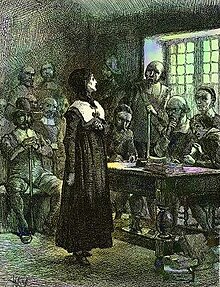List of 999 women on the Heritage Floor / Anne Hutchinson
This list describes the place setting for Anne Hutchinson on the table of Judy Chicago's art installation The Dinner Party . It is part of the list of 999 women on the Heritage Floor who are assigned to the respective place settings on the table. The names of the 999 women are on the tiles of the Heritage Floor, which is arranged below the table and belongs to the art installation.
description
The installation consists of a three-sided table, each with 13 historical or mythological personalities, thus a total of 39 people, from prehistory to the women's rights movement . These people were assigned a place setting at the table, consisting of an individually designed table runner, an individually designed plate, a goblet, knife, fork, spoon and serviette. The first page of the table is devoted to prehistory up to the Roman Empire , the second to Christianization up to the Reformation and the third from the American Revolution to the women's movement. Each place setting on the table is assigned additional personalities who have received an entry on the tiles of the Heritage Floor, which occupies the space under the table and the center of the space between the sides of the table. This list includes the personalities assigned to Anne Hutchinson's place setting. Your seat is on the third side of the table.
Hints
In addition to the names as they are used in German transcription or in scientific usage, the list shows the spelling chosen by Judy Chicago on the tiles.
The information on women who do not yet have an article in the German-language Wikipedia is referenced by the individual references listed under comments . If individual information in the table is not referenced via the main article, additional individual references are given at the relevant point. If there are any discrepancies between the information provided in Wikipedia articles and the descriptions of the work of art on the Brooklyn Museum website , this will also be indicated under Comments.
Place setting for Anne Hutchinson
Anne Hutchinson was born as Anne Marbury in July 1591. She married Wiliam Hutchinson at the age of 21 and moved with him and the religious leader John Cotton to the British colony of Massachusetts in 1634. In her ward, she began holding weekly meetings that men and women could attend to discuss the final sermon. This led to increasing criticism of the Puritan practice and it came into conflict with the religious leaders of the settlement. She was tried in 1637 and expelled from the community. She and her husband moved to Rhode Island . There she foundeda religiously liberal colonywith Roger Williams , who had alsobeen banishedfrom the Puritan society of the Massachusetts Bay Colony . She later moved with her family to New York State, where she and her entire family were killed in an Indian attack in 1643.
Because of her religious belief that someone who achieved the status of "chosen" was considered equal in the group, she refused to raise the clergy above the other believers. This spiritual security of the elect made the role of the priests as mediators between God and man and as interpreters of God's word superfluous. The attitude of passive waiting in the conviction of being chosen brought the image of an ideal Christian closer to the social role of women and thus led to the appreciation of women. This created a significant attraction for women and this is considered an early form of feminism .
The place setting for Anne Hutchinson on the dinner party table takes up the motif of mourning; Grief for a great person, family member, or friend. There are several representations of grieving women on the table runner. In addition, a large weeping willow spans the space on which the plate is placed. This is designed similarly and in terms of color and shape, the painting on the plate takes on the shape of the weeping willow. Another element on the back of the table runner is a Greek urn on a gravestone base. She is flanked by two grieving women. Another grieving woman is on the front, next to the signature. The initial letter “A” is filled with the structure that can also be seen on the plate. The table runners and plates are made in dark earth tones, which underline the symbolism of mourning. For Chicago, the 17th century was a particularly low point in women's history. For them it was a symbol of the declining power of women that a religious woman was banished from society by the church. This low point is expressed in the place setting by the motif of mourning.
| Surname | Spelling on the tile | Date of birth | cultural spatial assignment | Remarks | image |
|---|---|---|---|---|---|
| Abigail Adams | Abigail Adams | 1744 | Province of Massachusetts Bay , United States | Wife of second US President John Adams and mother of US President John Quincy Adams . As an adviser to her husband, she had a great influence on politics and advocated women's rights . |

|
| Ann Lee | Ann Lee | 1736 | New York Province | Joined the Shakers and moved to America after being held in an English prison over a vision that influenced the Shaker belief system about celibacy . She went to prison again in New York for treason after refusing to swear allegiance. She was called "Mother Ann" and she preached in New England . Her work inspired her followers to create the United Society of Believers in Christ's Second Appearing . |

|
| Anne Bradstreet | Anne Bradstreet | around 1616 | Massachusetts Bay Colony | The first English-language poet whose works were published in the colonies of the New World. |
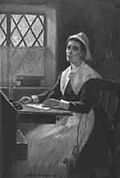
|
| Catharine Littlefield Greene | Catherine Greene | 1755 | United States | Wife of the general of the Revolutionary War , Nathanael Greene , mother of five children and is known supporter of the inventor Eli Whitney to be. |
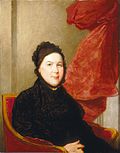
|
| Deborah Sampson | Deborah Sampson | 1760 | United States | Woman who dressed up as a man to serve in the Continental Army during the American Revolutionary War . She is part of a small number of women with a documented record of military combat experience in that war. She served as "Robert Shurtliff" of Uxbridge, Massachusetts for 17 months in the Army. She was wounded in 1782 and honored in 1783 at West Point, New York. |

|
| Eliza Lucas Pinckney | Eliza Lucas Pinckney | 1760 | United States | Planter . At the age of sixteen, she took over the management of his three plantations in South Carolina during her father's absence due to the war . It is thanks to her that the indigo plant was first cultivated and distributed in the United States. George Washington acted as her pallbearer. | |
| Hannah Adams | Hannah Adams | 1755 | United States | Writer and the first woman in the United States to work as a writer and to earn a living writing. |

|
| Hannah Mather Crocker | Hannah Crocker | 1752 | United States | Essayist and one of America's earliest advocates of women's rights. | |
| Helena Petrovna Blavatsky | Helen Blavatsky | 1831 | Russian Empire | Occultist . In 1875, Blavatsky founded the Theosophical Society with Henry Steel Olcott . |

|
| Henrietta Johnston | Henrietta Johnston | around 1674 | Carolina Province | Pastel painter in the English colonies in North America from circa 1708 until her death. | |
| Judith Sargent Murray | Judith Murray | 1751 | United States | Early campaigner for women's rights as well as an essayist, letter writer, playwright and poet. |

|
| Margaret Brent | Margaret Brent | 1601 | New England , Province of Maryland | Important settler in founding Maryland. |

|
| Margaret Fell | Margaret Fell Fox | 1614 | England | Important female figure of early Quakerism . |

|
| Margaret Hardenbroeck | Margaret Philipse | 1637 | New York Province | Prominent and wealthy business woman in the colonial province of New York. | |
| Marie de l'Incarnation | Marie de l'Incarnation | 1599 | Canada | Nun , mystic and missionary in Canada, was beatified by the Roman Catholic Church in 1980 |
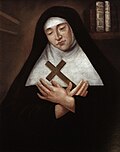
|
| Mary Alexander | Mary Alexander | 1693 | New York City , Province of New York | Influential, wealthy clerk in New York during colonial times. |

|
| Mary Baker Eddy | Mary Baker Eddy | 1821 | United States | Developed Christian Science , published her main work Science and Health with Key to the Holy Scriptures in 1875 and founded the worldwide Christian Science Church. |

|
| Mary Bonaventure Browne | Mary Bonaventure | after 1610 | Ireland | Poor Clare and Historian. | |
| Mary Dyer | Mary Dyer | around 1611 | England , Massachusetts Bay Colony | Quaker , the last religious martyr in North America, hanged in Boston, Massachusetts for repeatedly entering the city despite the Quakers banished from it. |

|
| Mary Katherine Goddard | Mary Goddard | 1738 | United States | First American publisher, post office manager of the Baltimore Post Office from 1775 to 1789. |

|
| Mercy Otis Warren | Mercy Otis Warren | 1728 | New England , Massachusetts | Political writer and American Revolution propagandist . |

|
| Molly Pitcher | Molly Pitcher | 1754 | United States | Woman who fought at the Battle of Monmouth . |
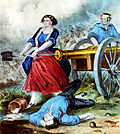
|
| Penelope Barker | Penelope Barker | 1728 | United States | An American Revolution activist who organized a boycott of British goods in 1774 known as the Edenton Tea Party. |

|
| Phillis Wheatley | Phillis Wheatley | around 1853 | United States | First African American poet whose works were published. |
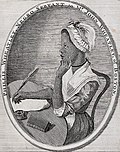
|
| Sarah Miriam Peale | Sarah Peale | 1800 | United States | Painter who painted still lifes , but mostly portraits. |

|
| Selina Hastings | Selin Hastings | 1707 | England | She was a key figure in the evangelical revival of England in the 18th century. She converted to Methodism and then founded her own Church of Calvinist Methodists, which she financed herself. |

|
| Susanna Wesley | Susanna Wesley | 1669 | England | Mother of John and Charles Wesley and the wife of Samuel Wesley . She is also known as the "mother of Methodism " as she greatly influenced John and Charles Wesley through her upbringing. |

|
- Individual evidence
- ^ Brooklyn Museum: Anne Hutchinson. In: brooklynmuseum.org. Retrieved October 28, 2019 .
- ↑ Brooklyn Museum: Catherine Greene. In: brooklynmuseum.org. Retrieved October 27, 2019 .
- ^ Brooklyn Museum: Hannah Crocker. In: brooklynmuseum.org. Retrieved October 27, 2019 .
- ^ Brooklyn Museum: Henrietta Johnston. In: brooklynmuseum.org. Retrieved October 27, 2019 .
- ^ Brooklyn Museum: Judith Murray. In: brooklynmuseum.org. Retrieved October 27, 2019 .
- ↑ Brooklyn Museum: Margaret Brent. In: brooklynmuseum.org. Retrieved October 27, 2019 .
- ^ Brooklyn Museum: Margaret Philipse. In: brooklynmuseum.org. Retrieved October 27, 2019 .
- ↑ Brooklyn Museum: Mary Alexander. In: brooklynmuseum.org. Retrieved October 27, 2019 .
- ^ Brooklyn Museum: Mary Bonaventure. In: brooklynmuseum.org. Retrieved October 27, 2019 .
- ^ Brooklyn Museum: Mary Goddard. In: brooklynmuseum.org. Retrieved October 27, 2019 .
- ↑ Brooklyn Museum: Mercy Otis Warren. In: brooklynmuseum.org. Retrieved October 27, 2019 .
- ↑ Brooklyn Museum: Molly Pitcher. In: brooklynmuseum.org. Retrieved October 27, 2019 .
- ↑ Brooklyn Museum: Penelope Barker. In: brooklynmuseum.org. Retrieved October 27, 2019 .
- ↑ Brooklyn Museum: Selin Hastings. In: brooklynmuseum.org. Retrieved October 27, 2019 .
Web links
- Brooklyn Museum, Anne Hutchinson
- The Dinner Party on the website of Through the Flower , Judy Chicago's non-profit organization
